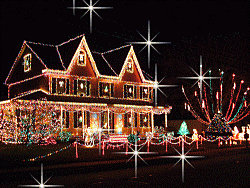Holiday Lighting and Electrical Safety

Holiday lighting is an age-old tradition and great way to brighten up your home with holiday cheer. However, holiday lights when not used properly, can create dangerous hazards, including fires.
During this time of year, it’s especially important to implement the electrical safety tips that you’ve come to know. By taking the proper precautions both inside and outside of your home, you can prevent hazards and instead focus on what is important during the holidays.
- Get Rid of Incandescent String Lights -- Replace old incandescent strings of lights with LED lights. LED lights are far less of a fire hazard and are cool to the touch unlike incandescent bulbs. In addition, LED bulbs are less of a hassle, if a bulb breaks the other lights on the string won’t go out.
- Get Rid of Damaged Lights -- Inspect your lights for frays or cracks in the cords. If you find any damage throw them away. It’s not worth the risk of a fire.
- Look for Empty Sockets -- Empty sockets can cause the entire string of lights to overheat, be sure to replace any dead light bulbs.
- Look for the UL Exterior Lights Rating -- Exterior lights, unlike those used inside the house, need to be weather-resistant. The same goes for any extension cords used outdoors. Lights should be approved by Underwriters Laboratory (UL). UL will be displayed on the tag, signifying the product has been inspected for potential safety hazards. Red UL marks indicate the lights are safe for indoor/outdoor use, and green UL marks indicate the lights are only safe for indoor use.
- Attach Strings of Lights With UL-Approved Clips -- Nails and staples cut through the wire insulation and create a fire hazard. Instead, use UL approved clips to safely attach lights to the house.
- Use Outdoor GFCI Outlets (If Possible) -- When plugging in outdoor lights or decorations look for GFCI outlets. GFCIs help prevent electric shock by breaking the circuit when differences in the currents of hot and neutral wires occur.
- Use the Proper Extension Cords Outdoors -- Only use heavy duty outdoor cords as they are designated for outdoor usage.
- Don’t Overload Extension Cords -- Use no more than three sets of standard lights per cord.
- Prevent Tripping Hazards -- Place cords in low traffic areas to prevent people from tripping, walking on or crushing cords.
- Don’t Let holiday Lights Touch Flammable Items -- Holiday lights should not touch furniture, drapes, or carpeting.
- Use a Timer on Your Lights -- A timer will save you on energy bills and prevent you from forgetting to turn off lights, risking a fire hazard from overheating.
- Don’t Leave Holiday Lights Up Too Long -- Don’t leave holiday lights up for more than 90 days. The longer they stay up, the more likely they are to suffer damage from weather and critters chewing on them.
- Store Lights Properly -- Tangled lights can lead to damaged cords, broken sockets, and a headache next year.
Keep an eye on your holiday lights and check them throughout the season for safe operation. Most importantly enjoy the holidays!
Related Reading
Subscribe to our e-Newsletter
Stay up-to-date on current news, promotions, and industry tips.
